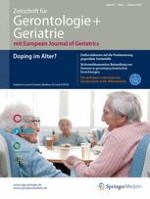Anzeige
20.12.2017 | Themenschwerpunkt
Antikörper als Therapieoption bei geriatrischen Patienten
Erschienen in: Zeitschrift für Gerontologie und Geriatrie | Ausgabe 2/2018
Einloggen, um Zugang zu erhaltenZusammenfassung
Monoklonale Antikörper kommen bereits für viele Indikationen zum Einsatz. Abseits der Onkologie und der Rheumatologie kommt bei geriatrischen Patienten aktuell nur der Antikörper Denosumab zur regelmäßigen Anwendung. Neben Osteoporose gibt es zahlreiche weitere mögliche Anwendungsbereiche von Antikörpern bei chronischen Erkrankungen und geriatrischen Syndromen. Insbesondere im Zusammenhang mit der Sarkopenie erscheint der Übergang zum „Doping des Älteren“ fließend. Der vorliegende Review gibt einen Überblick über den aktuellen Stand der klinischen Entwicklung und mögliche Optionen für die Zukunft.















